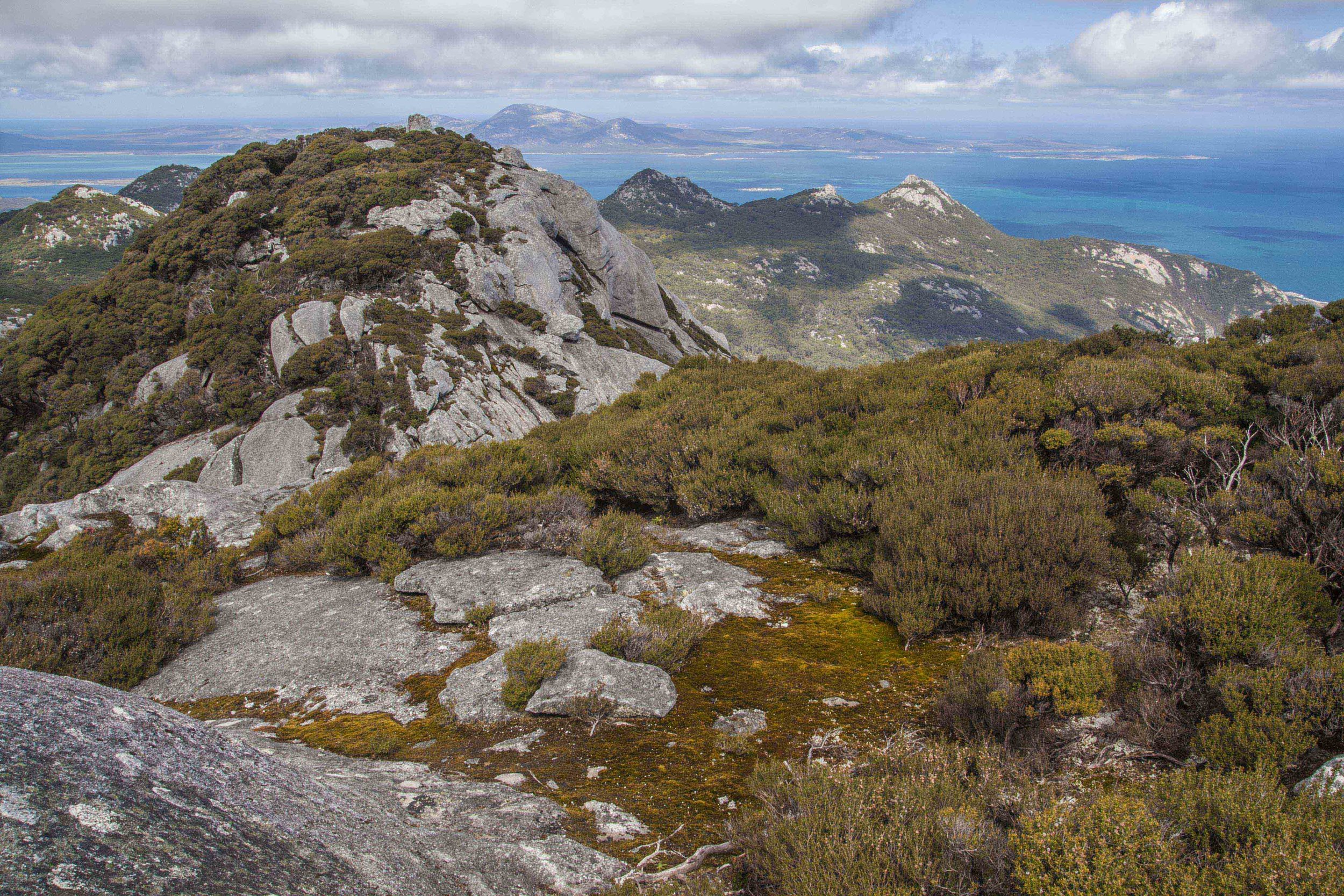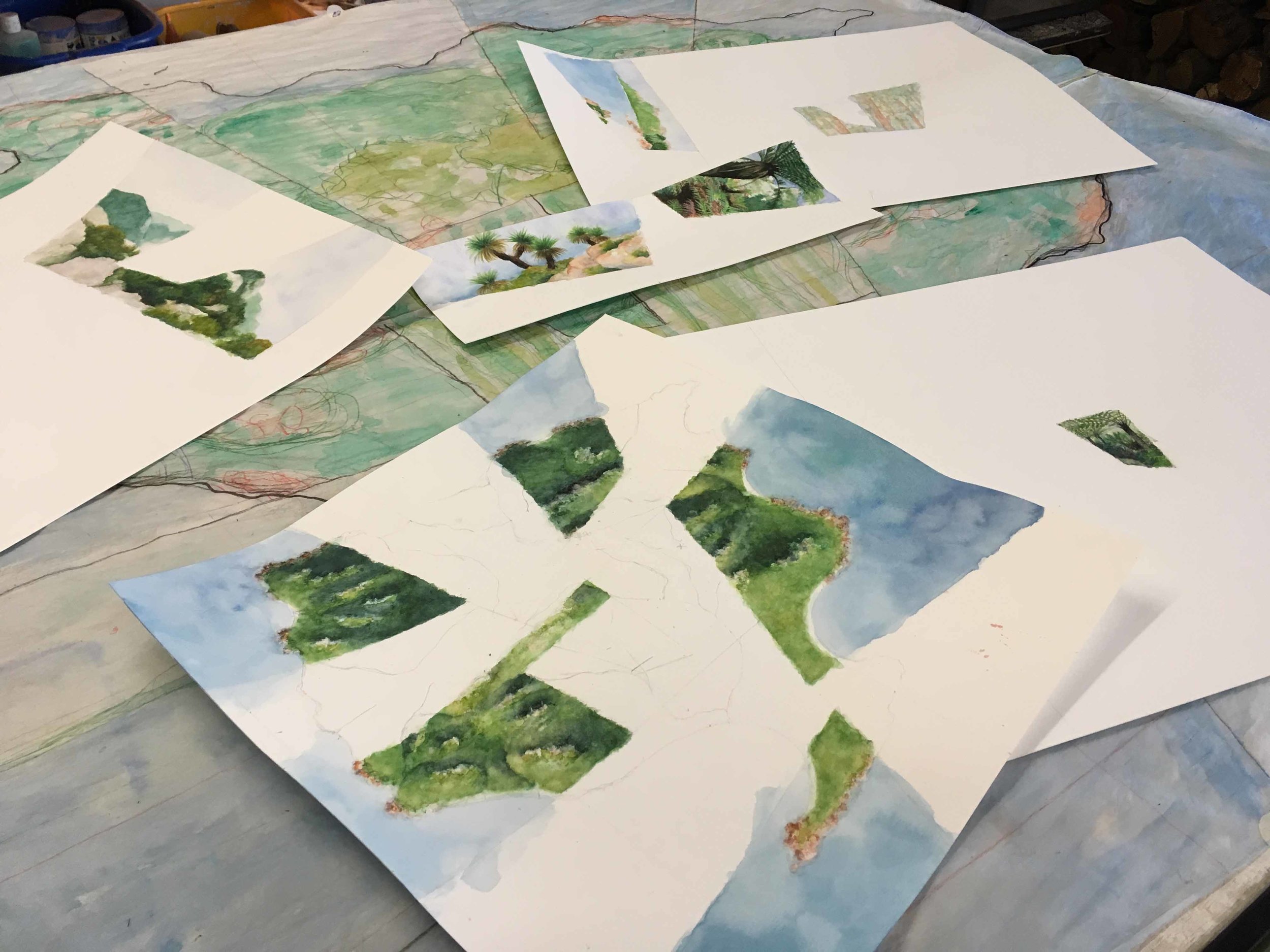This post picks up where I left off two posts ago with Strzelecki National Park on Flinders Island, Tasmania, and the worldview it inspired. The Park protects the most intact and diverse ecosystems of the island, where I did a month-long artist residency at Mountain Seas Art and Wilderness Retreat in September 2017.
Strzelecki National Park, and the relatively pristine mountains and coastline adjacent, has only three interior routes. The 4-5 hour round-trip hike to Strzelecki Peak begins about a 15-minute bike ride from Mountain Seas; a much longer but basically level one follows a road and 4wd track just inland along the south coast; and an hour-long walk winds along the coastline north from Trousers Point.
I hiked to the summit twice, both times lucking out with the weather. It’s definitely in my top five day-hikes of all time, and isn’t difficult except for a few steep, rocky patches near the top. The trail begins in dry mixed and Eucalyptus forest, punctuated by bare or scrubby areas of granite boulders and cut by a dramatically lush, tree-fern filled rainforest gully. As the trail rises and approaches the sheer cliffs of the peak, the rocky areas become more frequent.
Rainforest gully surrounded by Eucalyptus forest.
View of Strzelecki Peak (above my head) from the lower slopes.
Mid-slope view down to Trousers Point.
Patches of montane rainforest start to appear, mossy and windswept. Where the soil allows, the rainforest becomes more luxuriant, though unlike the gully far below the tree ferns are short and ragged. It’s wet enough for them up there but almost too cold—an ecological “zone of tension” (there’s probably a proper scientific term for that?), world-shrinking in the way that I experience other ecotones but here in a particularly visceral way. Reaching the peak itself, the vegetation becomes drier and sparser once again, reaching tree-height only in pockets between the boulders.
Wind-sculpted rainforest approaching the Peak.
View of the Peak from below the last push.
Tree ferns near the upper limit of their range.
Rainforested slope just below the Peak.
View south from the summit.
The south coast walk is more homogeneous given the constant elevation, though it passes through impressive stands of grass trees (Xanthorrhea australis) and provides access to a number of completely empty, idyllic beaches and areas of coastal forest.
A few of the south coast’s many empty beaches.
Grass trees in dry forest along the south coast.
The short coastal walk from Trousers Point joins two more spectacular beaches, but the combination of windswept coastal heath, giant boulders (stained red by algae) and open views is unique on the island. I did that walk two or three times, the last on one of my final nights during a spectacular sunset that worked magic on the red ground and ochre vegetation.
Coastal heath vegetation, backed by windblown forest, near Trousers Point.
Coastal heath near Trousers Point at sunset, with Strzelecki Peak hidden in the clouds beyond.
After walking each trail once, I decided that although the interior of the park and adjacent natural areas is mostly inaccessible, I could work with the portion of it that, from the Peak trail and the perimeter combined with some satellite imagery to get my bearings and tie everything together, I could get a handle on. (This work of overlaying my experiential map onto the “actual” aerial map isn’t truly essential for the worldviews in paper, since I only have space to fit a few experiences that I decide are key to visualizing the essence of the whole. But the “artworks” are only an incidental, imperfect manifestation of my urge to structure and comprehend the natural world, rather than ends in themselves—hence the quotation marks. In my head, I’m driven to complete the experiential map as much as possible.) I took the satellite view of that “knowable” subset of the Park and sketched it as if it were its own true island surrounded by water, imagining that the new coastline would resemble the existing one. I then pared down my photos to the most representative and interspersed them among pieces of the aerial view that gave the most complete sense of the overall geography.
As always happens, the painted version diverged from the photos to varying degrees, most significantly in the coastal view in the lower right of the finished work. There I added grass trees that didn’t actually grow so close to the rocky water’s edge, “compressing” several experiences into one as a way to structure and intensify the overall diversity of the landscape. I decided on the cut/layered paper approach partly because I felt it would be truer to the compositional style and partly because I thought it would result in crisper edges. Both considerations ended up being not valid enough to justify the added complexity, but it was an interesting exercise to determine the layering order of the sheets—which views felt more “interior” vs. “exterior.”
The original plan was for this small piece (15”x15”) to act as a study for a larger one that would be more feasible to create back home after the residency. I never ended up doing that—I think Sanctuary works well enough as a stand-alone work—but ultimately I think there’ll be another one or two worldviews that come out of this experience. The one I currently have in mind puts the National Park back on Flinders Island, placing more emphasis on its real-life role as a refuge from mostly human impacts.
Sanctuary, watercolor on layered paper, 15”x15”
Looking north across the mostly cultivated plains of Flinders Island from the ecological sanctuary of Strzelecki National Park.
Sanctuary highlights a tension within my focus on islands and island-like, isolated environments. On one hand the worldviews carry a conservation-oriented message. The natural places they depict are now few and far-between, and the species and ecosystems within are in danger not just because by definition rare things face a more precarious existence than common things but because smallness and isolation bring unique vulnerabilities. A higher percentage of edge habitat means more exposure to harmful influences such as invasive species, light, and wind. Real or “ecological” islands historically isolated by water, climate, soil conditions etc…are particularly susceptible to invasive species against which they have no defenses, and their native species have nowhere to go when climate change makes their homes uninhabitable. Small population sizes are difficult to sustain not just because numbers are few but because genetic diversity is reduced. And many animal species require geographic ranges of a minimum size to thrive.
But on the other hand, it’s the very smallness and isolation of these places that attracts me—not just because (like many people) I find rare and unique things particularly interesting, but because these places are easier to grasp. The smaller they are, the easier to explore and absorb. So a part of me actually likes the fact that so much of Flinders Island’s native environment can only be found within Strzelecki National Park, even though it also frightens me. This conflict has surfaced even more clearly in some of my more recent worldviews where I depict natural relicts within human-dominated landscapes—I find the juxtaposition simultaneously exhilarating and distressing. I get the sense that these are in fact the works that people are most drawn to, and I’m curious as to which half of the conflict—or possibly the tension itself as in my case, or something entirely different—has the primary impact. I’ll be posting a lot more on this particular question!
Darren
Strzelecki National Park at sunset, from the beach north of Trousers Point.




































